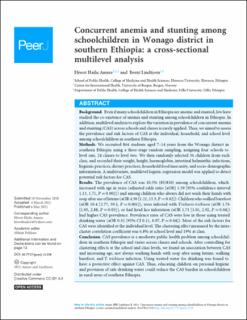| dc.description.abstract | Background: Even if many schoolchildren in Ethiopia are anemic and stunted, few have studied the co-existence of anemia and stunting among schoolchildren in Ethiopia. In addition, multilevel analysis to explore the variation in prevalence of concurrent anemia and stunting (CAS) across schools and classes is rarely applied. Thus, we aimed to assess the prevalence and risk factors of CAS at the individual, household, and school level among schoolchildren in southern Ethiopia.
Methods: We recruited 864 students aged 7–14 years from the Wonago district in southern Ethiopia using a three-stage random sampling, assigning four schools to level one, 24 classes to level two. We then randomly selected 36 children from each class, and recorded their weight, height, haemoglobin, intestinal helminthic infections, hygienic practices, dietary practices, household food insecurity, and socio-demographic information. A multivariate, multilevel logistic regression model was applied to detect potential risk factors for CAS.
Results: The prevalence of CAS was 10.5% (85/810) among schoolchildren, which increased with age in years (adjusted odds ratio [aOR] 1.39 [95% confidence interval 1.13, 1.71, P = 0.002]) and among children who always did not wash their hands with soap after use of latrine (aOR 4.30 [1.21, 15.3, P = 0.02]). Children who walked barefoot (aOR 10.4 [2.77, 39.1, P = 0.001]), were infected with Trichuris trichiura (aOR 1.74 [1.05, 2.88, P = 0.03]), or had head lice infestation (aOR 1.71 [1.01, 2.92, P = 0.04]) had higher CAS prevalence. Prevalence rates of CAS were low in those using treated drinking water (aOR 0.32 [95% CI 0.11, 0.97, P = 0.04]). Most of the risk factors for CAS were identified at the individual level. The clustering effect measured by the intra-cluster correlation coefficient was 6.8% at school level and 19% at class.
Conclusion: CAS prevalence is a moderate public health problem among schoolchildren in southern Ethiopia and varies across classes and schools. After controlling for clustering effects at the school and class levels, we found an association between CAS and increasing age, not always washing hands with soap after using latrine, walking barefoot, and T. trichiura infection. Using treated water for drinking was found to have a protective effect against CAS. Thus, educating children on personal hygiene and provision of safe drinking water could reduce the CAS burden in schoolchildren in rural areas of southern Ethiopia. | en_US |

